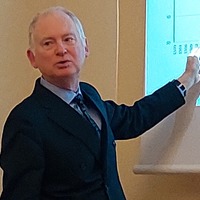
Gregory Hanlon
Munro Professor of History and Distinguished Research Professor at Dalhousie University: Trained in France in the Annales tradition, I study behaviour in historical societies with the aid of the behavioural sciences broadly, from human ethology, to evolutionary psychology, rational actor sociology (Boudon) and anthropology. This extends and updates the Annales project, which combined history with the social and behavioural sciences broadly speaking. Ideologies take a back seat in this neo-Darwinian approach.
Over the years this has resulted in books on religious history, military history and a couple of close studies of communities in 17th-century Italy and France where it was possible to situate everyone by name over the space of two generations. The textbook on early modern Italy 1550-1800 (2000) was the first synthesis aimed at that period in any language. Another textbook on early modern military history (2020), embracing almost all of Europe between 1500 and 1750 is the first wide-ranging synthesis in several decades.
"Death Control in the West 1500-1800" (2022) analyzes sex ratios from more than 600,000 baptisms and a score of status animarum censuses, analyzes dozens of rural and urban communities in Italy, France and England. It demonstrates that post-partum abortion was a key component of the Western demographic system, similar to most other peoples on the planet.
Present research focuses on display behaviour in Baroque Italy, ca. 1570 to ca. 1740, from top to bottom of urban and rural society in Farnese Parma and Piacenza. It begins with an exploration of universal aesthetic instincts and their wider social ramifications in early modern Europe.
Over the years this has resulted in books on religious history, military history and a couple of close studies of communities in 17th-century Italy and France where it was possible to situate everyone by name over the space of two generations. The textbook on early modern Italy 1550-1800 (2000) was the first synthesis aimed at that period in any language. Another textbook on early modern military history (2020), embracing almost all of Europe between 1500 and 1750 is the first wide-ranging synthesis in several decades.
"Death Control in the West 1500-1800" (2022) analyzes sex ratios from more than 600,000 baptisms and a score of status animarum censuses, analyzes dozens of rural and urban communities in Italy, France and England. It demonstrates that post-partum abortion was a key component of the Western demographic system, similar to most other peoples on the planet.
Present research focuses on display behaviour in Baroque Italy, ca. 1570 to ca. 1740, from top to bottom of urban and rural society in Farnese Parma and Piacenza. It begins with an exploration of universal aesthetic instincts and their wider social ramifications in early modern Europe.
less
Related Authors
Ajay Parasram
Dalhousie University
Christopher Cohoon
St. John's College, Santa Fe
Shaun Miller
Boston University
Christopher R Austin
Dalhousie University
Gillian Austin
Trent University
Erin Spinney
The University of New Brunswick
InterestsView All (53)










Uploads
Papers by Gregory Hanlon
Books by Gregory Hanlon
This contribution will try to speak to both communities of scholars, on the off chance that practicing historians will wish to rethink their problems afresh from the perspective of human nature. Historians often assume that all of our practices are subject to constant change, where we can apply a date to observable shifts in behavior. Human nature posits that some things change slowly or not at all, and this helps explain the uncanny similarity of the situations and motivations one finds across time and space. This section will pass in review some of the main acquisitions of a half-century of evolutionary inquiry for the benefit of historians, without pretending that scholars follow identical approaches or reach the same conclusions. I have no need here to take sides in the debates between evolutionary psychologists, human behavioral ecologists, or ethologists, or to choose between individual or group selection. Evolutionary thinking can inform a vast array of historical problems; indeed, it embraces every facet of human activity, but in this brief contribution, I will discuss only four areas at more length: reproduction, interpersonal conflict and violence, war, and aesthetics.
army with a view to joining the French alliance against Spain in 1635, he was gratified by
a turnout of astonishingly high proportions. Not nearly enough of them had personal
experience of modern war, and so the prince appointed military nobles from much of
northern Italy to fill the cadres, alongside the French officers whose contingents on loan
from Louis XIII made up a third of the infantry. Unlike Spanish nobles, Odoardo’s
subjects were even willing to serve in the ranks, while waiting for their advancement.
The two brief campaigns turned out to be a disaster for Odoardo and his subjects. War
quickly receded from Parma’s horizon, but the experience reveals that Italy’s aristocrats
had not yet consigned their weapons to display cases.
L’evento bellico, in questo lavoro, è stato sottoposto a un’analisi che si articola a partire da tre differenti prospettive. In primo luogo, la battaglia appare come occasione per il manifestarsi di tendenze e congiunture che attraversano la storia e che spesso sorpassano l’esistenza degli uomini, come momento rivelatore di fratture e discontinuità. I saggi inseriti nella seconda parte del volume pongono al centro del loro interesse la condotta della guerra, nel tentativo di restituire il vissuto dei protagonisti dello scontro dal punto di vista materiale come da quello culturale e religioso. La terza sezione del volume, infine, è dedicata alla memoria e alla rappresentazione della battaglia. L’evento è dunque esaminato nella sua proiezione e ri-significazione nel tempo, attraverso il prisma del racconto che a questo attribuisce rilevanza e dona senso, divenendone condizione d’esistenza. In questa parte, dunque, si indaga su come l’avvenimento sia «creato» a partire dalla narrazione che di questo viene diffusa sin dall’immediatezza, e sulle modalità con cui esso è continuamente manipolato e trasfigurato al fine di costruire nuove identità particolari e collettive.
INDICE DEL VOLUME
Introduzione
di Alessandro Buono e Gianclaudio Civale
Le siège de Malte (1565), coup d’arrêt de la conquête ottomane en Méditerranée occidentale
di Anne Brogini
Sources for a battle: Tornavento (22 June 1636)
di Gregory Hanlon
Demografia, sussistenza e governo dell’emergenza a Pavia durante
l’assedio del 1655
di Mario Rizzo
Ceresole (14 aprile 1544): una grande, inutile vittoria. Conitto
tra potenze e guerra di logoramento nella prima età moderna
di Michele Maria Rabà
«Non nobis Domine». Religione, disciplina e violenza nel corpo di
spedizione pontificio nella Francia della terza guerra di religione
di Gianclaudio Civale
Il racconto della battaglia. La guerra e le notizie a stampa nella Milano degli Austrias (secoli XVI-XVII)
di Alessandro Buono e Massimo Petta
La bataille de Saint-Cast (1758) après la bataille: l’événement au fltre des mémoires
di David Hopkin, Yann Lagadec e Stéphane Perréon
Abstracts
Indice dei nomi